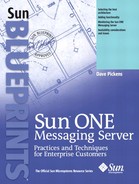Directory
The directory or user store in the messaging architecture stores user information such as ID, password, and email address. The software of many messaging servers utilizes the user store mechanism of the host, such as /etc/hosts on the Solaris OE. Others, such as the Sun ONE Messaging Server, utilize a directory or LDAP service to store and access user information.
The Sun ONE Messaging Server ships with and requires a fully compliant LDAP directory that contains directory objects specific to the Sun ONE Messaging Server software. These directory objects extend the default Internet Engineering Task Force (IETF) schema with additional attributes. A complete guide to the Sun ONE Messaging Schema is part of the existing documentation.
These additional attributes contain information such as an alternate address, or alias as it is sometimes called. Other attributes are used to store user preferences for web mail and configuration information about email services, as well as group information (mailing lists) and personal address books. In the Messaging Server software, information regarding processing a user's inbound email such as vacation messages, server side filters, and forwarding is also stored in the directory.
The directory is a lot like a database—a very small, fast database. One thing to note is that when directories or LDAP were originally developed, they were primarily designed to be mainly read oriented, say a 90 percent read and 10 percent write ratio. Today's usage of the directory has changed significantly. Things like messaging, calendar, and portal all store preferences and information in a directory server. The read/write ratio is now closer to 80 percent read and 20 percent write. So it is critical that the directory is available and performance of the directory is good or better than good.
